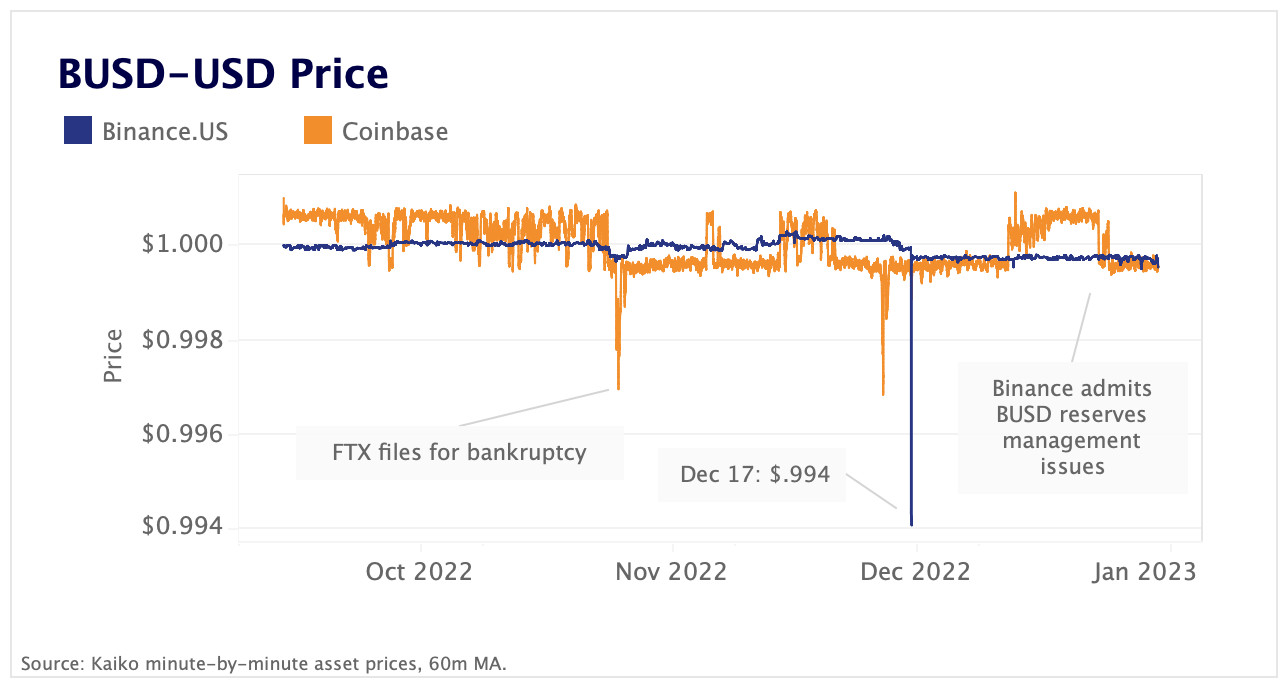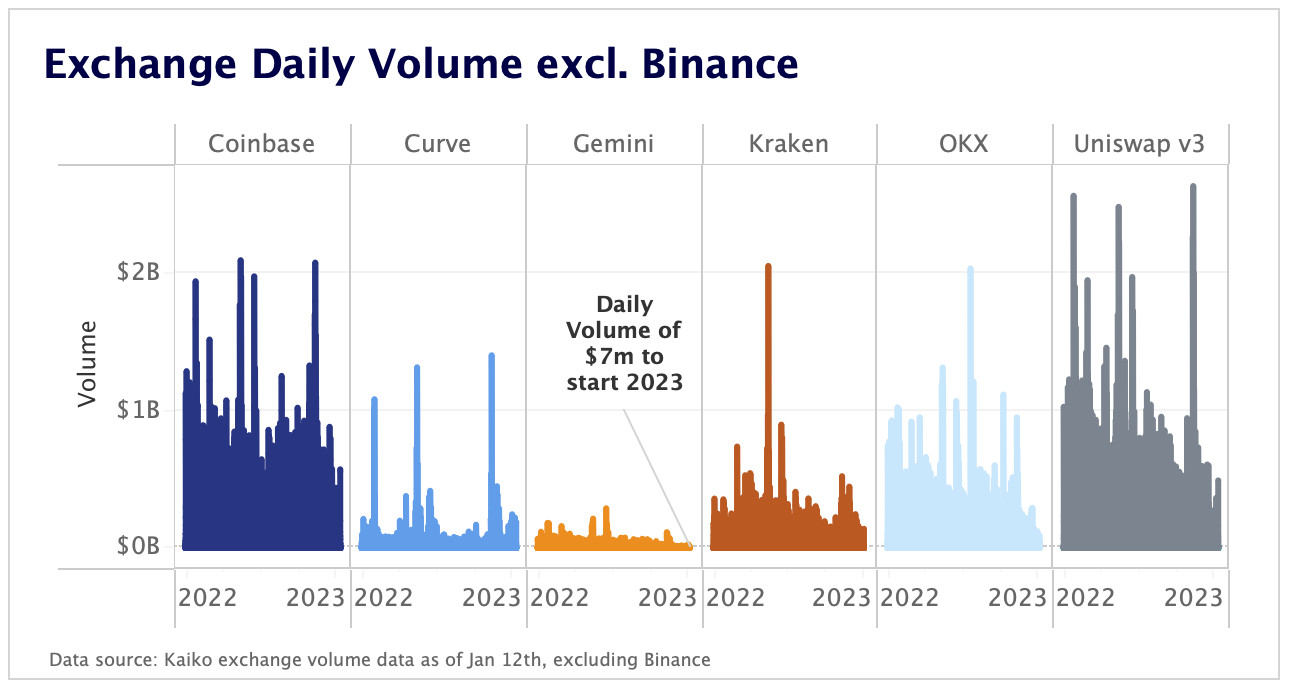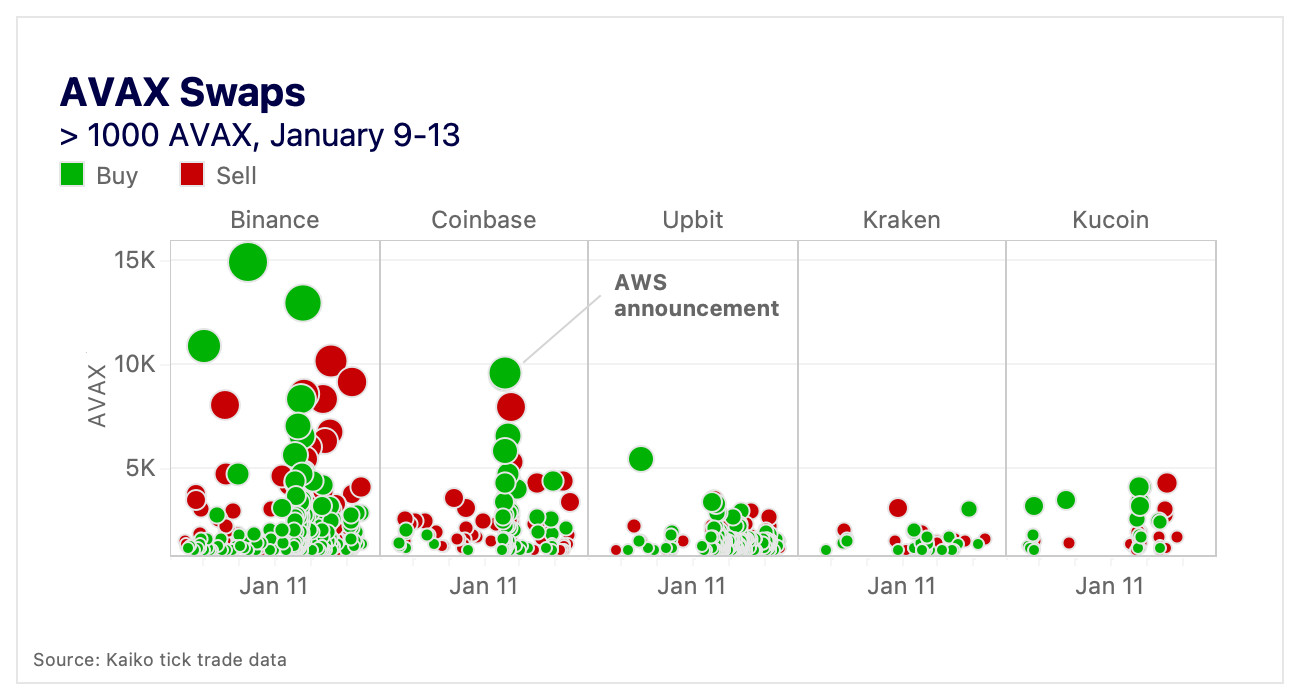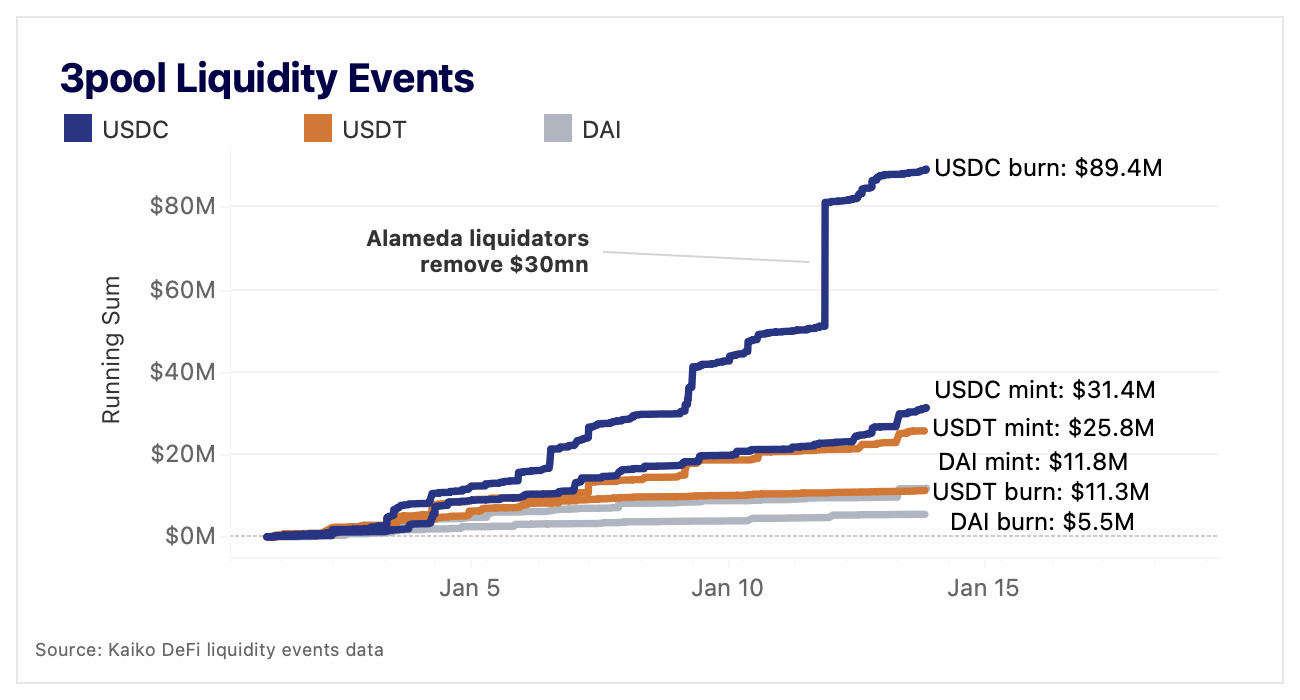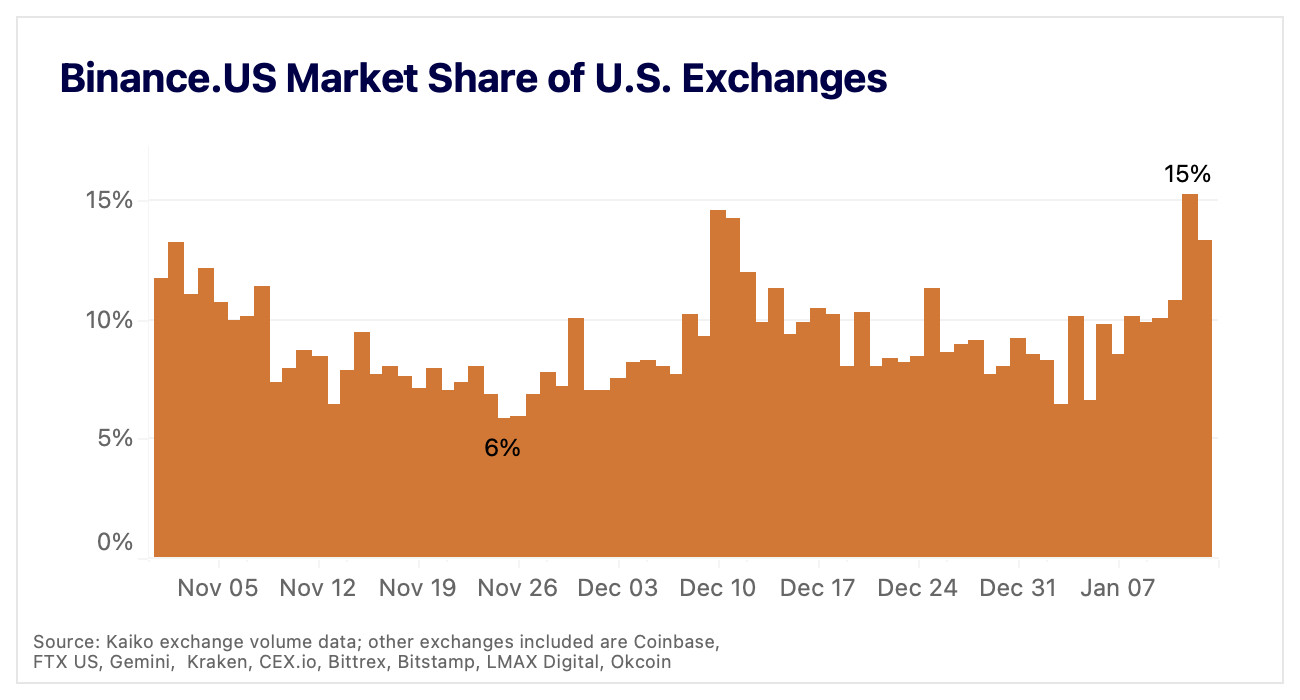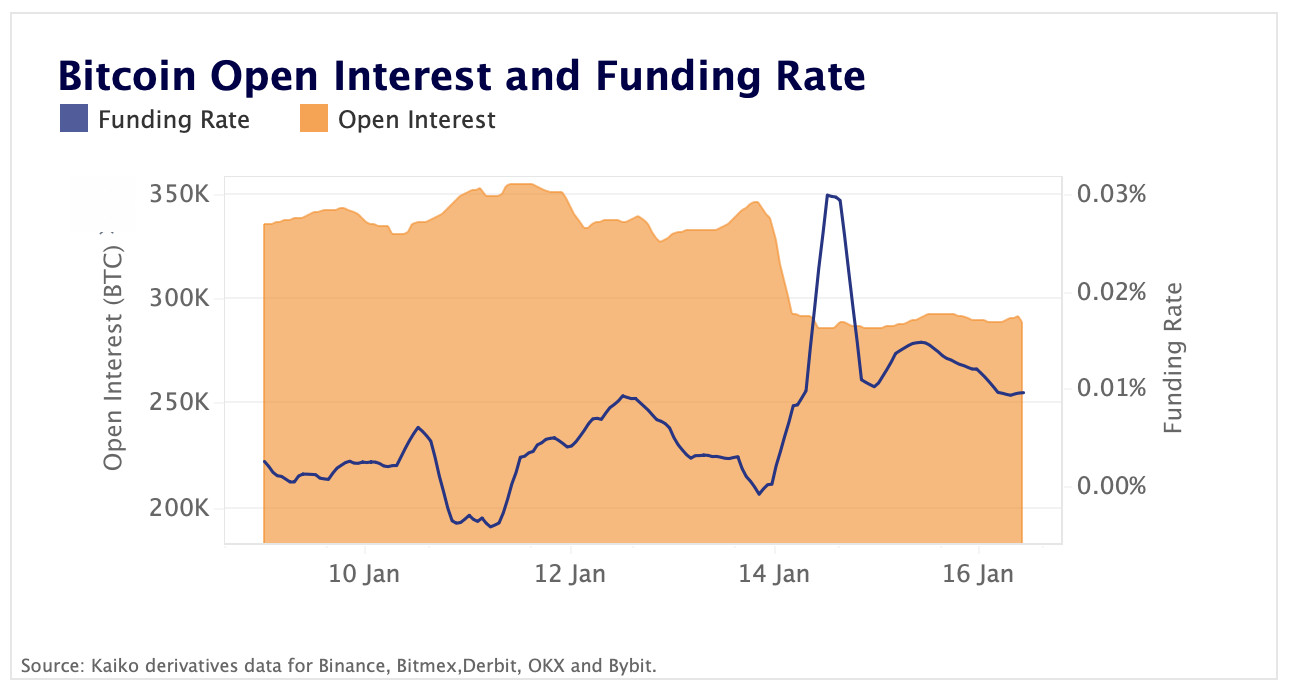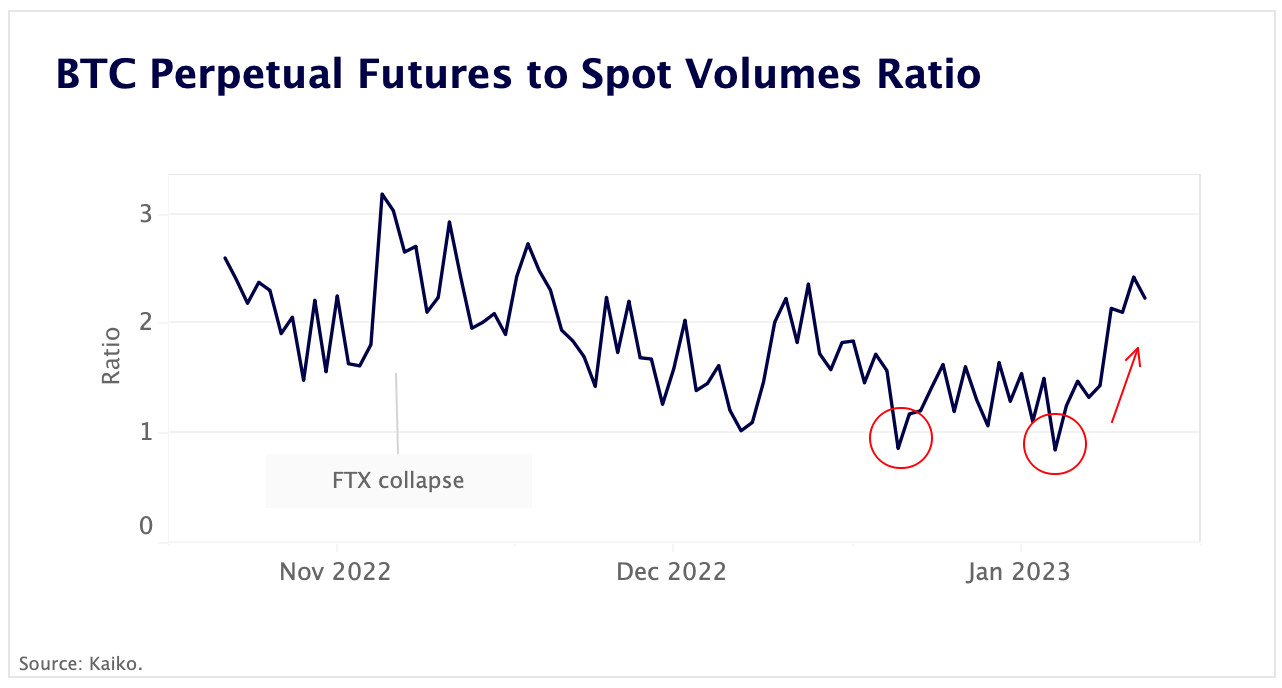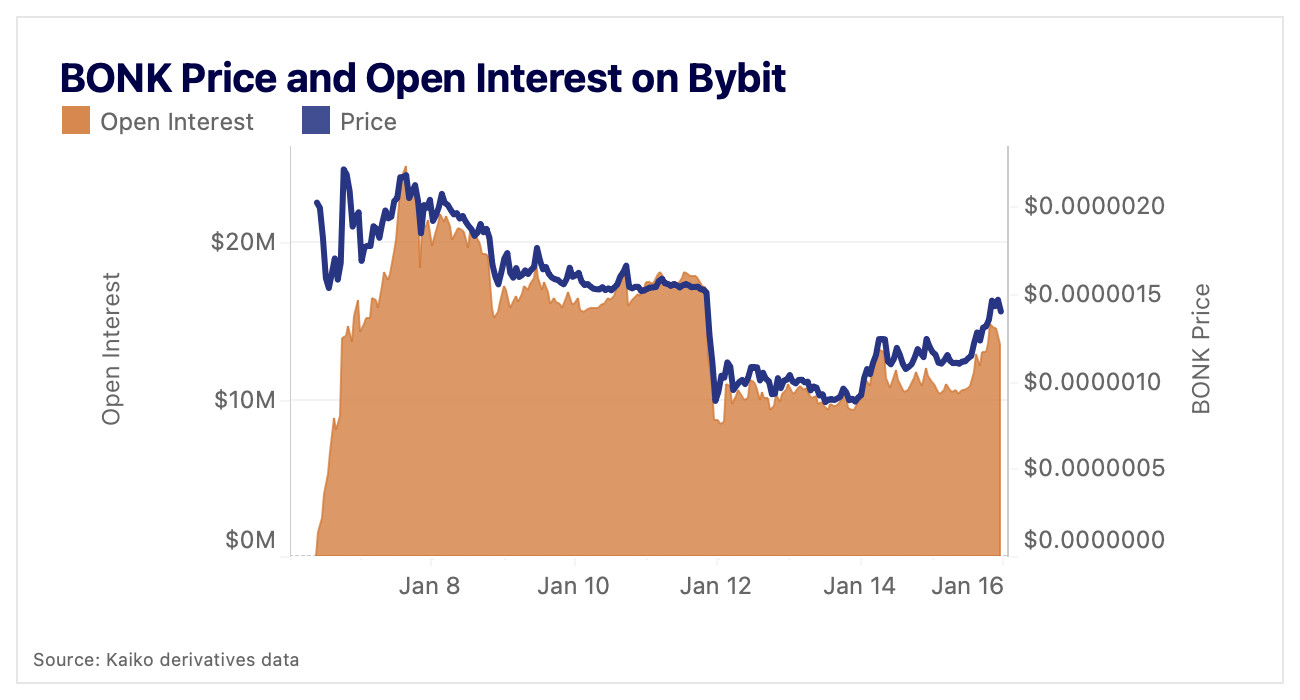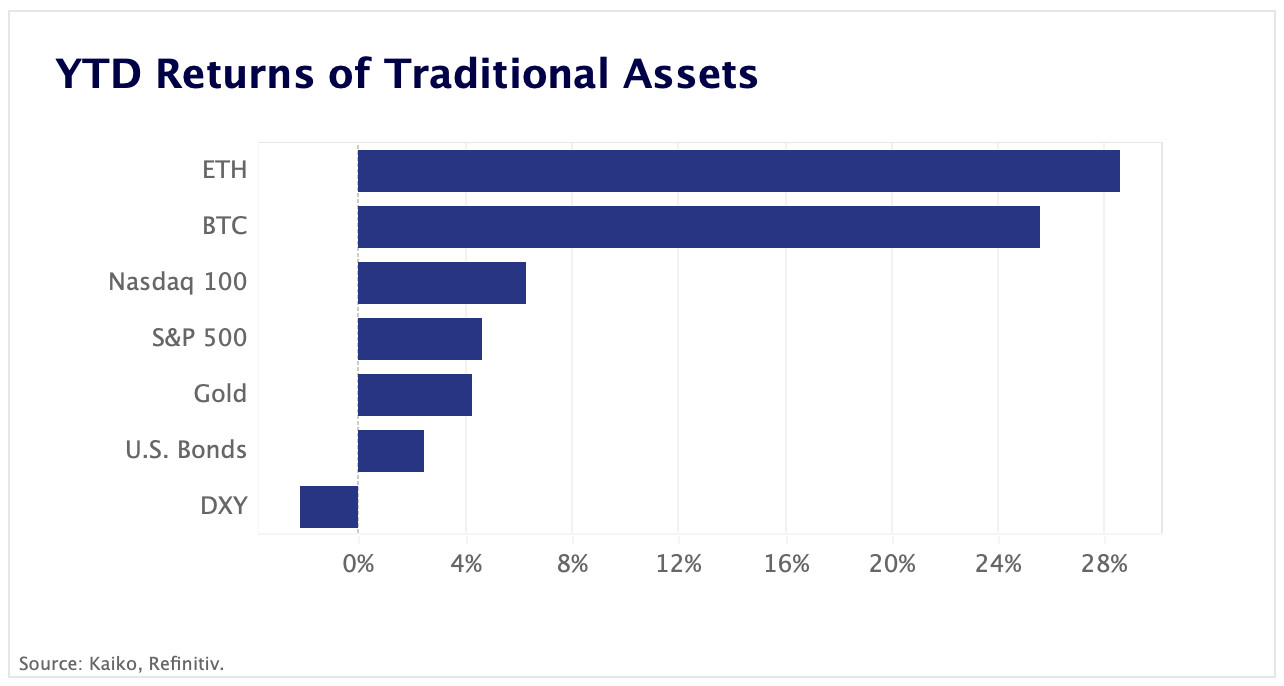A summarizing review of what has been happening at the crypto markets of the past week. A look at trending sectors, liquidity, volatility, spreads and more. The weekly report in cooperation with market data provider Kaiko.
The last 7 days at the cryptocurrency markets:
- Price Movements: Bullish sentiment has returned to crypto, with BTC up 20% over the past week.
- Market Liquidity: Binance.US's market share relative to other U.S. exchanges climbed to 15%, a marked increase after dropping to 6% post-FTX.
- Derivatives: BTC open interest fell sharply after a short squeeze caused millions in liquidations.
- Macro Trends: Crypto is strongly outperforming equities to start the year.
The Return of the Bulls
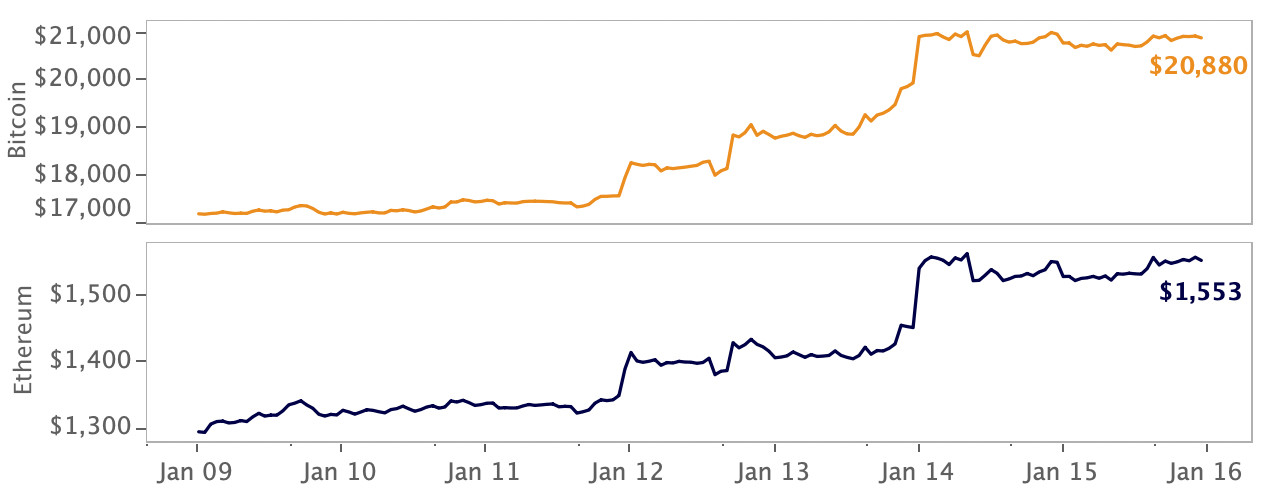
Last week saw the return of some much needed positive sentiment in crypto markets, with Bitcoin's (BTC) and Ethereum (ETH) up a massive 20% and 17% on the week, respectively. BTC trade volumes also hit their highest levels since the FTX collapse in November, although liquidity as measured by market depth has not yet recovered. In other industry news, Coinbase announced another round of layoffs, Avalanche revealed a new partnership with AWS, and FTX claims to have located $5bn in assets.
BUSD volatility has increased since November
BUSD-USD volatility has surged on the two main markets for the pair – Coinbase and Binance.US – since November. This has been mirrored by a 30% drop in BUSD market cap since mid-November. BUSD trades against the U.S. Dollar on only a handful of centralized exchanges with limited liquidity, which helps explain the volatility. However, in contrast to Tether’s USDT, verified investors are able to freely redeem their BUSD for USD via Paxos without a fee and a sizeable $100k threshold, thus reducing the importance of BUSD spot markets.
On Coinbase, the price of BUSD fell to $0.997 on November 11 after FTX filed for bankruptcy and remained mostly below its peg before recovering at the end of the year. BUSD lost its peg again last week after Binance admitted it had not always fully backed the wrapped version of the stablecoin, Binance-peg BUSD. Binance.US offers the deepest liquidity for the pair, yet it still fell to $0.994 on December 17 and currently trades at a discount similar to Coinbase's pair.
Historically, prices have been more volatile on Coinbase, which offers significantly thinner liquidity for BUSD-USD pairs despite accounting for 40% of trade volumes. The BUSD-USD bid-ask spread hovers around 10bps on Coinbase vs. just 1bps on Binance.US.
Despite rally, liquidity has not recovered since the FTX collapse
BTC and ETH rallied over the past week, but when looking at liquidity across 17 exchanges, we can observe order book depth remains low. Market depth recovered towards the end of December, but since the start of 2023 has again started sinking and is now about where it was in the worst of the FTX aftermath. It is unclear why liquidity temporarily recovered but failed to stick around, especially over the past few days, which has seen the highest trade volumes since early November.
Gemini spot volumes lag amid Genesis troubles
Crypto lender Genesis and exchange Gemini, who ran a crypto lending product in partnership with each other, both landed in some legal hot water last week as the SEC sued both companies. The SEC alleges that Gemini's crypto asset-lending program, which was powered by Genesis, was not properly registered as a securities offering.
Withdrawals from Gemini Earn have been suspended since November due to Genesis's liquidity issues and the program was terminated earlier this month. Daily spot volumes on Gemini have suffered amid the Earn controversy, and slipped as low as $7mn so far in 2023, lagging behind its main competitors, including OKX, Kraken, and Coinbase, as well as the decentralised exchanges Curve and Uniswap.
Large buys of AVAX roll in following AWS partnership news
Ava Labs, the company supporting the Avalanche blockchain, announced last week that it is partnering with Amazon Web Services (AWS). There are plans to make it easier for individuals and institutions to launch subnets – essentially purpose-built blockchains with their own membership and tokenomics that are still connected to Avalanche.
On the news, the associated token AVAX surged from $12.50 to over $16. The vast majority of large swaps occurred on Binance and Coinbase. In the two hours after the announcement, Binance processed nearly $100mn in AVAX volume; Coinbase did just under $17mn. However, when looking only at large orders greater than 5,000 ($80k at the time), Coinbase processed the most at just under $1mn.
Burns of USDC outpace all other events in Curve's 3pool
Since the start of the year, nearly $90mn USDC has been removed from the 3pool, compared to just $31.4mn USDC added. USDT and DAI events have been less active, with a net of $14.5mn USDT and $6.3mn DAI added to the pool this year.
This trend has been exacerbated by a single removal of $30mn USDC by Alameda liquidators, who have been active across a variety of DeFi protocols (including accidentally getting liquidated on Aave). Despite a disproportionate amount of USDC being removed, the pool has actually become more balanced since the beginning of the year, driven by swaps from USDC to USDT outpacing the reverse.
Binance.US's market share recovers after post-FTX dip
Ahead of FTX’s collapse, Binance.US had become an important player in the U.S., consistently accounting for 10% of trading volumes amongst U.S.-regulated exchanges that Kaiko covers. However, following FTX’s collapse – and counter to Binance global’s trend – Binance.US’s market share halved, falling to just 6%. Its share again spiked in mid-December before falling again amid Binance's crisis of confidence.
Since the start of 2023, its market share has again grown, from 9% to a high of 15% on January 12. It is likely that Binance.US is being affected by fears surrounding its global counterpart and the experience of FTX.US customers, who have been unable to withdraw their funds (despite Sam Bankman-Fried claiming that FTX US is fully solvent and customers should be able to withdraw) because of FTX International’s troubles.
BTC markets hit by short squeeze
Soaring spot prices triggered a short squeeze on BTC markets last week, with hundreds of millions of liquidations recorded as bearish traders were caught on the wrong side of price movements. BTC open interest denominated in both native units and USD tumbled between January 13-14 while funding rates spiked to their highest levels in months before retreating slightly. As of Monday morning, funding rates for most altcoins remain positive, suggesting that longs outweigh shorts and market sentiment could be improving.
Overall, capital inflows into derivatives market have slowed significantly after the collapse of FTX, with both trade volumes and open interest plummeting. The BTC perpetual futures to spot volumes ratio hit a multi-year low earlier this month with perpetual futures volumes falling below spot volumes for the second time in just a few weeks. It has since rebounded sharply after last week's short squeeze boosted volumes on derivative markets. However, it remains well below its levels from before the FTX collapse, indicating that a lot of the leverage that was active in the derivatives markets prior to FTX has been flushed out now, arguably leaving crypto with a healthier market.
BONK open interest finds a floor as price swings
BONK, the Solana dog coin airdropped to Solana traders, NFT holders and artists, and developers, fell over 50% last week before surging 50% this weekend. Bybit is the first and only major exchange to offer perpetual futures for the token, and it quickly surged to $25mn in open interest.
However, this has since fallen along with price, crashing from $17mn to $9mn in just three hours. Open interest and price seemingly found floors in the $10mn and $0.000001 areas, respectively, before jumping over the weekend. The token has revived interest in the Solana ecosystem, as its whitepaper states that the ecosystem has “been the victim of predatory VC tokens… BONK strives to become the true community coin of Solana.”
Crypto outperforms equities as risk sentiment improves
BTC and ETH are up double-digits in percentage terms this year, outperforming traditional assets as risk sentiment improves. The Nasdaq 100 is up 6% YTD while Gold and U.S. Bonds rose by 4% and 2% respectively. Last week, U.S. CPI data showed that inflation has eased in December, for a sixth month in a row, boosting hopes that the Fed will pause its aggressive rate hiking in May.
In contrast, the U.S. Dollar has continued weakening this year and is now more than 10% below its peak in September 2022. A softer dollar is typically supportive of risk assets. Bitcoin’s correlation with the greenback has been mostly negative over the past year, falling to as low as -0.6 in early January before rebounding to -0.4 last week.


